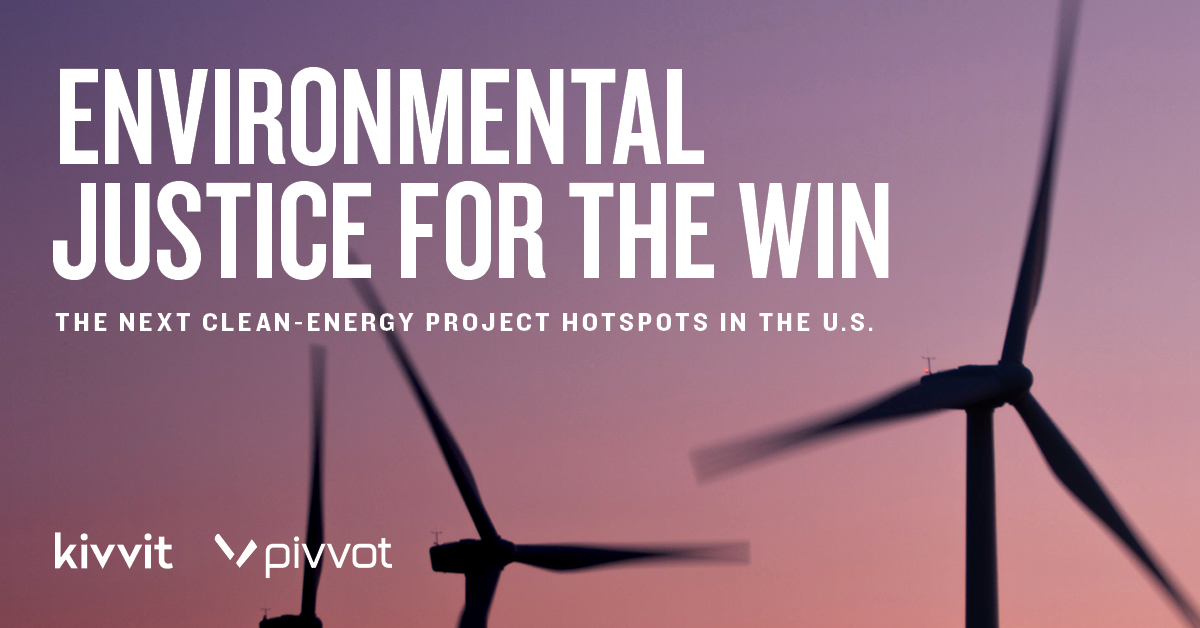Kivvit in partnership with Pivvot, a location intelligence company, released “Environmental Justice for the Win: The Next Clean-Energy Project Hotspots in the U.S.”
This data-driven report shows clear opportunities for successful clean-energy development in areas where political, equity, and energy-demand rationales overlap. Months in the making, the in-depth report overlays energy grid locations with deep socioeconomic data and state-by-state policymaker statements about environmental justice.
The report notes that public statements by U.S. elected officials on the subject of “environmental justice” has increased some 750% in the last five years — from just 1,694 mentions in 2017 to 14,433 mentions in 2021. California has the highest number of public statements from elected officials on environmental justice, followed by Oregon and Connecticut.
“This emphasis on environmental justice coincides with the rise of the federal government’s investment in energy infrastructure,” said Jonathan Scharff, Director of Insights at Kivvit. “This is an important factor for state permitting agencies, elected officials, and regulators. It is now more critical than ever for energy developers to understand local implications and engage communities so their project can create beneficial outcomes for all stakeholders.”
After analyzing thousands of data points around policymakers’ involvement, current energy projects, and social vulnerability, the report identifies the geographical regions where environmental justice is — or is anticipated to be — a primary concern in the context of renewable energy development. Populous states such as California already have high energy-development intensity, while states including Arizona, Kentucky, and New Mexico are poised to be the next generation of energy hotspots.
Advances in location intelligence software create opportunities for energy developers and planners to intentionally assess environmental justice as a factor in energy planning.
“As we have demonstrated in the report, socioeconomic, community, and energy data sources are more abundant than ever,” said Rich Henry, Director of Customer Success at Pivvot. “Sophisticated developers understand this and analyze the data to find the best locations for their clean energy projects that satisfy technical, commercial, and stakeholder needs.”
Other key findings from “Environmental Justice for the Win: The Next Clean-Energy Project Hotspots in the U.S.” include:
- The prevalence of populous states that have high energy-development intensity, as well as higher social vulnerability and high elected official interest in environmental justice, suggests that energy planners operating in these states should be hyper-focused on environmental justice when setting up new energy projects. These states include California, Connecticut, Illinois, Massachusetts, New York, Pennsylvania, Texas, and Virginia.
- Some states have medium levels of environmental justice conversation among elected officials, as well as areas of high energy-development intensity. This suggests environmental justice could become more relevant in energy-project development in states including Maine, Maryland, Ohio, and Texas.
- Some states have less congested energy-project queues but see some level of elected-official chatter about environmental justice and also have areas of socioeconomic vulnerability. This suggests energy planners should expect to encounter a heightened level of focus on environmental justice issues when proposing new energy projects in such states, which include Arizona, Kentucky, Louisiana, New Mexico, North Carolina, and West Virginia.




